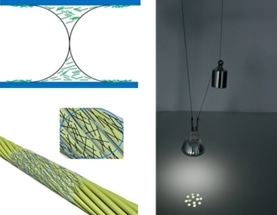Dec 28 2018
A group of scientists from Nanjing, China, has devised a simple, low-cost, scalable, and capillary-driven self-assembly technique for producing conductive fibers that have high conductivity, uniform morphology, and better mechanical strength.
 A simple, scalable and low-cost capillary-driven self-assembly method has been developed to prepare conductive fibers with uniform morphology, high conductivity, and good mechanical strength. By coating highly conductive and flexible silver nanowires on the surfaces of yarn and PDMS fibers, high-performance fiber-shaped flexible and stretchable conductors are fabricated, which have great potential for application in wearable devices. (Image credit: World Scientific)
A simple, scalable and low-cost capillary-driven self-assembly method has been developed to prepare conductive fibers with uniform morphology, high conductivity, and good mechanical strength. By coating highly conductive and flexible silver nanowires on the surfaces of yarn and PDMS fibers, high-performance fiber-shaped flexible and stretchable conductors are fabricated, which have great potential for application in wearable devices. (Image credit: World Scientific)
Dr Yi Li and Yanwen Ma, from the Key Laboratory for Organic Electronics and Information Displays, Institute of Advanced Materials (IAM) of Nanjing University of Posts and Telecommunications, and his colleagues have come up with a simple, low-cost, scalable, and capillarity-driven self-assembly process for preparing silver nanowires (Ag NWs) coated stretchable and flexible conductive fibers.
The capillary action of fibers such as nylon, cotton, and polyester yarns as well as PDMS fibers is exploited for the solution containing Ag NWs to be spontaneously absorbed into the capillary tunnels. Subsequently, through an evaporation-induced flow and capillary-driven self-assembly process, Ag NWs are evenly coated onto the fibers to create conductive fibers, which is in situ observed by the optical microscopic measurement. The fabricated stretchable and flexible conductor has high conductivity, uniform morphology, and better mechanical strength, which is propitious for application in smart fabrics and wearable electronics.
Metal wires like copper and stainless steel wires, as well as the metal film coated yarn, are traditionally used as conductive fibers. These fibers are brittle and stiff, and hence do not meet the demands of comfortability and flexibility for smart textiles.
Smart textiles containing electronic devices such as transistor, sensor, battery, light emitting diode, and supercapacitors integrated into fabrics have gained significant attention. Conductive yarns and fibers, with the ability to connect different electronic devices, have a vital role in smart textiles system. In the recent past, conductive nanomaterials such as carbon nanotubes, metal nanomaterials, and graphene with optimal mechanical properties, high conductivity, feasibility of large-scale production and solution-process have turned out to be an innovative type of fundamental materials for conductive fibers.
There have been tremendous efforts to engineer conductive nanomaterials into conductive fibers through different technologies like electrospinning, vapor deposition, and spray coating methods. In spite of these promising advances, the large-scale, facile, and cost-effective fabrication of conductive fibers with good electrical conductivity and high flexibility is still challenging.
This study was partially funded by the National Natural Science Foundation of China and Keypoint Research and Invention Program of Jiangsu Province.